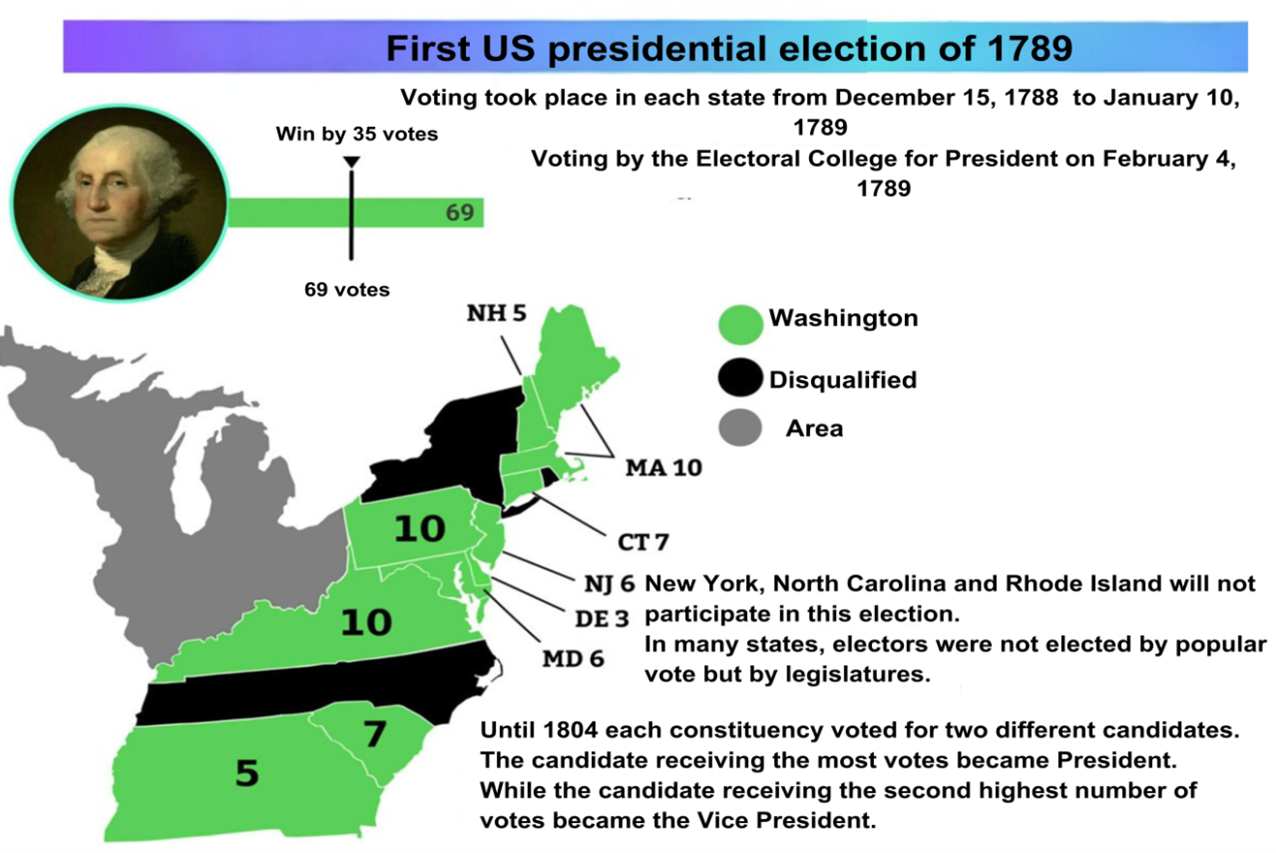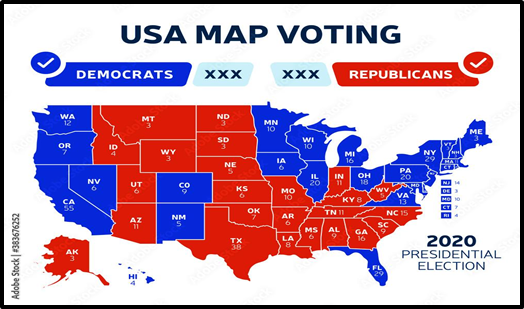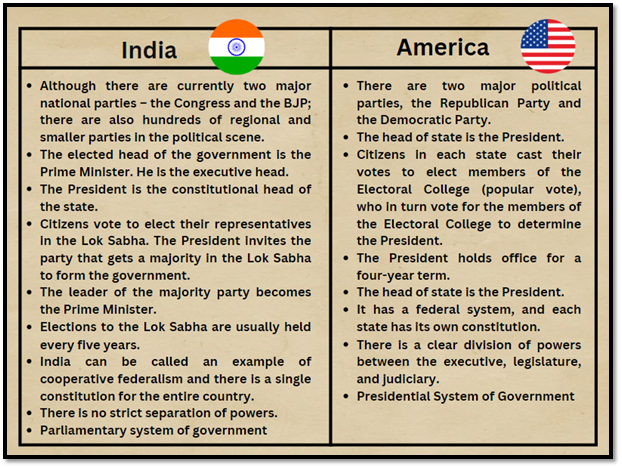- Table of Contents
- Reference:
- Background of US Presidential Election
- Republican Party
- Democratic Party
- Result of US Presidential Election 2020 -
- Candidates for the upcoming US Presidential Election:
- Eligibility for US Presidential Election:
- Process of US Presidential Election:
- Comparison between Indian Government and US Government:
Reference
- Date of elections: November 5th ,2024.
- The winner of the election will be appointed as the President on the January 20, 2025 assuming the heading of a four-year term. In this election, voters will not only be selecting the presidential candidates, but also such legislative representatives as House of Representatives and the US Senate.
Early history of the US Presidential Election
- In the United States of America generally in every four years Presidential election is held to choose the president of the country. The electoral process is laid down as per the US constitution especially Article II and has gone through changes with the growth of the nation.
- After the first presidential held in the 1789, Mr George Washington became Americas first president.

Republican Party
- The Republican’s or often referred to as the “GOP” stands for Grand Old Party is second largest political party in the United States.
- This party was originated in 1854 by Anti-slavery currents.
- From 1860s to 1932 it was among the major party of the country.
- The 40% of Presidents of America have been from the Republican Party i.e 44 presidents out of which 18 belong to this party.
Democratic Party
- The Democratic Party is an officially recognized political party in America which is in sharp focus as the largest single political parties in the country.
- The Democratic Party has its early beginning in the United States of America in the year 1828, till date 15 presidents emerged from this party.
- The first Democratic Party president was Andrew Jackson, his presidency began in 1829 and ended in 1837.
- From this part John Boehner served as the Speaker of the house and the sir Barack Obama became the president. (2009-2017)
2020: Outcome of the US Presidential poll.
- The presidential event that happened in 2020 in the United States was the 59th quadrennial presidential elections.
- For example, Joe Biden, the former Vice President of the United States of America, emerged the new and the 46th President of the United States of America after highly competitive and fierce polls against the incumbent Republican President, Donald Trump.
- It was conducted at a time of the global COVID-19 pandemic and related global recession.
- According to the available records, this election had the largest voter turnout by percentage since 1900; both candidates who clinched the presidency received over 74 million votes outdoing Barrack Obama’s 2008 record of 69 million votes. 5 million votes. Biden got more than 81 million of votes.

Prospective contestants for the presidency of the United States of America
- There will be voting and the president will be chosen for a four year term. Incumbent President Joe Biden from the Democratic party of America is seeking re-election.
- The former president and a Republican Party leader Donald Trump is most likely to be the opponent against Mr Biden.
- Also, if Biden carries out his plans to get the nomination of the Democratic party and Trump also gets the nomination of the Republican party then it will be the first time the two are in the presidency election since the year 1956. Trump will be first former president to be on the ballot since Teddy Roosevelt in 1912.
Qualifications for election of US President: The qualification that the US Constitution provides for the president includes the following;
- Born on the territory of the United States of America
- Resident in the United States from 14 years Consequently,
- Min Age :35 years.
- An American citizen by birth refers to a person who is born with citizenship of the United States of America. This entails any child that is born in the United States or a child born in any other country, but is a holder of the United States citizenship through birth, naturalization or by descent.
President
- The US President is the head of the executive office and is voted through the Constitutional process after every four years. This is provided for in the US constitution in Article II, Section 1.
- The Executive power shall be vested in the President of the United States of America and he shall be in Office for a term of four years. "
- In three conditions as mentioned a person is entitled to be in the office of President:
- was born in the US,
- a United States Citizen or
- a citizen of the United States at the time of commencement of the Constitution.
- A person who is less than 35 years old and resident in United States for fourteen years shall also not be allowed to be a president.
- A candidate individual can be the President of the United States if the individual was born in the US or if he/she is a bonafide child of the United States citizen. Examples are:
- John McCain was still qualified to become a presidential candidate; despite being born in the Panama Canal Zone because of his American parents, he becomes American citizens automatically.
- The fact that the candidate was born in Mexico like the case of Michigan Governor George Romney also made him eligible to be a presidential candidate.
- Al Frankin of Arizona met the requirement when he was declared a candidate even though Arizona was not part of the United States at the time he was born in 1909.
Process of Electing the US President:
- Elections are also defined as a formal decision making process by which a population elects a person or more than one person to particular post in the government.
- The election of the President of the United States is a kind of indirect election where the citizens of the United States, eligible to vote in any of the fifty states or Washington, DC don’t directly vote for the offices, but for the members of the Electoral College.
- Before voting became a right in 1965, the constitution written in 1787 did not specify who had the right to vote in an election. Many states have never before allowed women or African Americans to vote.
- As 15th amendment was passed in 1870, this provided the male African Americans a chance to be allowed to a vote. In fact, blacks in America were not able to fully exercise this right for another 100 years.
- American women did not gain the civil right to vote on the national level until the year 1920. Later during the same year the 19th amendment to the constitution was ratified and the next November millions of American women voted in a presidential election for the first time.
- The 26th provision of the Constitution guarantees the right to vote, and is legally enforceable nationwide to persons of eighteen years and older.
- The due process incorporation refers to the act passed by Congress in 1965 that granted the voting rights to the races previously discriminated. This law ensured that federal government would come into vote if a state tried to intimidate a citizen into not voting because of their race. Due to this act, millions of blacks in the south of America could register as voters for the first time.
- Up to this time, the two main groups are the Democrats and the Republicans in our country. Yet, there are others that include the Independent Party, Reform Party, Libertarian Party, Green Party, and others that include Socialist Party, Populist Party amongst others.
The election process for the US presidency can be divided into five stages:
- Primaries and caucuses
- National convention
- Campaigning
- General election
- Electoral college.
Primaries and caucuses:
- The step starts in any of the first two months of the year with the Primaries and caucuses.
- The state and Local officials organize Primaries use of the secret ballet to provide nominations for each party’s likely prospective presidential candidates.
- Caucuses are close-door meeting held by the parties, and differently from a primary, voters do not directly choose a candidate.
- Here the voters openly declare which candidate they are with.
- Then, the organizers tally the votes and determine how many delegates the candidate is to be given.
National convention:
- Once the preferential contests called the primaries and caucuses to choose a party’s presidential candidate are concluded across individual states, a national convention takes place to declare the party’s nominee for the presidency to the country.
- At a convention, officials called elected delegates choose a party’s candidate while the candidate with the most delegates is given the party nomination. The procedure of the general election is initiated at the end of the convention.
Note :-
Each party holds a national convention to finalise the selection of a presidential candidate. At each convention, the presidential candidate chooses a vice-presidential candidate.
Election Campaign:
- The actual campaign follows the process of choosing each political party’s candidate through primary elections, caucus, and national convention.
- These candidates move from one region of the country to another campaigning to the public with their propositions and hopeful for the public to vote for them.
- The major feature of the campaign during the general election is rallies, debates, as well as advertisements.
General election:
- Indeed, the modern voters may be shocked when they hear that when they go to the polling booth to vote their candidate for the president, but is not like that they actually vote fellow Americans called the electors.
- Citizens in every state in the country go to the polls to vote for a president.
- When the voters put their cross on the ballot paper they are in fact voting for a group of people called electors. The above mentioned means that even if other fifty one per cent of the population of the USA votes for another candidate, he or she cannot become the president.
- Some of examples include cases where the candidate who got the highest votes did not be elected. Thus, for a candidate to emerge the winner in the election, he/she must secure more than 270 electoral votes.
Electoral college:
- On Election Day, the candidates stand for election and the electorate walks into the polling place and votes for the preferred candidate. The president is also elected for a particular tenure by means of the Electoral College.
- Each State is given a number of seats according to the number of seats that it currently has in the House of Representatives plus the Senate.
- Washington DC receives three electoral college votes but all the other areas in the USA that qualify to be a territory do not get any single vote. It means that there are total 538 electors.
- All the votes for the candidate are collected after the people casts their ballots and they are tallied state-wide. Contrary to this, Washington DC and 48 states employ the winner-take-all where the victory bearing candidate acquires all the electors of that state.
- Maine and Nebraska are exceptions for that reason since it has a proportional system. As min. electors for "win" is 270 electoral votes.
Comparison between Indian Government and American Government
